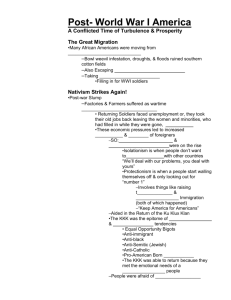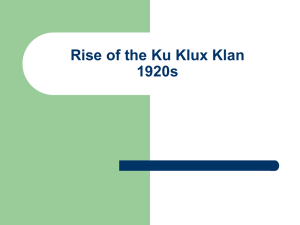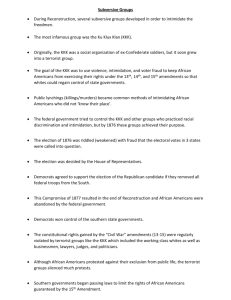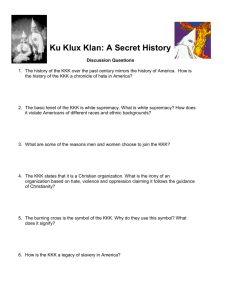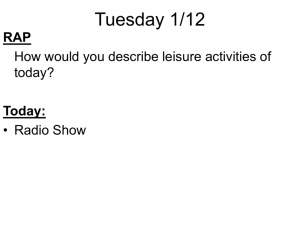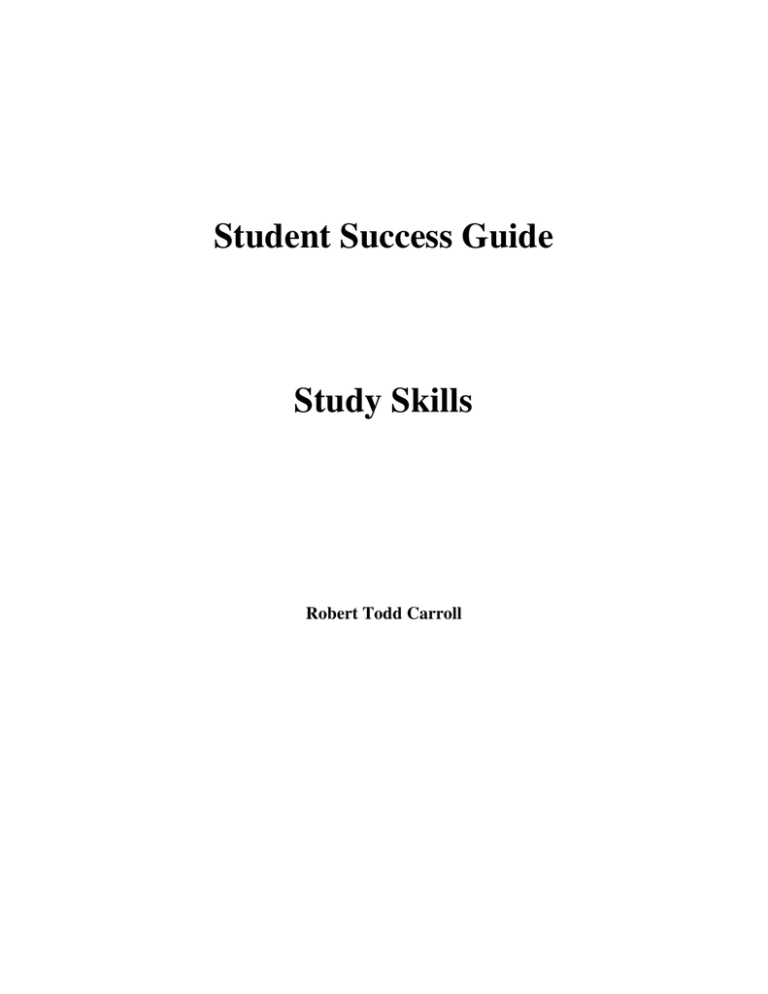
Student Success Guide
Study Skills
Robert Todd Carroll
Student Success Guide – Study Skills
© 1990 by Robert T. Carroll. All rights reserved.
No part of this book may be reproduced in any form or by any means, including
electronic storage and retrieval, or translated into a foreign language without prior
agreement and written consent from the author as governed by United States and
International Copyright Law.
Robert Todd Carroll
e-mail: rtc@skepdic.com
Website: The Skeptic’s Dictionary (www.skepdic.com)
Other books by Robert T. Carroll
•
The Common-Sense Philosophy of Religion of Bishop Edward
Stillingfleet, 1635-1699. (1975). (International Archives of the History of
Ideas / archives internationales d'histoire des idées). Martinus Nijhoff, The
Hague
•
Student Success Guide: Writing Skills (1990).
http://www.skepdic.com/refuge/writingskills.pdf
•
The Skeptic’s Dictionary: A Collection of Strange Beliefs, Amusing
Deceptions, and Dangerous Delusions. (2003). Wiley and Sons.
•
Becoming a Critical Thinker – A Guide for the New Millennium. (2005). 2nd
edition. Pearson Custom Publishing.
Chapter One available online at
http://www.skepdic.com/refuge/ctlessons/ch1.pdf
Preface
The purpose of the Student Success Guide: Study Skills book is to provide a systematic
approach to learning the skills needed by every successful student: skills such as vocabulary
building, time management, listening and concentration, reading and studying textbooks, taking
notes, reviewing and preparing for tests.
The Student Success Guide may be used independently by the student who wishes to
improve his or her chances of success in humanities and social science courses. The book could
also be used as the sole text in a Study Skills course or as an adjunct text in an English or
Humanities course.
The driving idea behind the Student Success Guide is that methodical and purposive
studying is the most effective and efficient. I don't claim that my method is the only one. In fact, I
can't even call it my method, since very little of it has been originated by me. I have taken the
work and suggestions of many people and applied them as I saw fit. What has resulted is a work
unified by the idea that purpose, method, practice, and a way of measuring achievement are
central to any effective and efficient learning.
The Student Success Guide is easy to use and understand, but it does not make studying
effortless. Any method which promises amazing results but requires no work is a sham. I can't
promise that if you follow the program here you will be able to learn Mandarin Chinese in a week
during your sleep (as one text I reviewed promised!). The successful student will have to work
hard. If you do, I can promise that you will not be uncertain about the payoff for the work put in. It
has been said before, but it bears repeating: you will get out of it what you put into it.
Robert T. Carroll
Sacramento City College
March 1990
Acknowledgment and dedication. For the first half of my teaching career at Sacramento City
College I was fortunate to have had Les Read as my colleague in the philosophy department. Les
was one of my closest friends until his sudden death at age 48. Ed Stupka—who taught college
success classes—Les, and I spent many fruitful hours discussing, arguing, and evaluating
various teaching techniques and ideas. Without their insights and criticisms, this guide would not
have been written.
The Los Rios Community College Board of Trustees granted me a sabbatical leave in the
spring of 1986 to complete this project.
ii
TABLE OF CONTENTS
1
4
11
Two Essentials
Vocabulary
Motivation
13
Study Skills
13
15
15
19
19
19
21
22
24
26
30
31
34
35
36
37
39
40
40
40
45
46
48
48
48
49
Time Budgeting
Concentration
Listening
Reading and Studying
Reading Skills/Effective Studying
Textbook Orientation
Previewing Textbook Chapters
Focused Reading: The Structure of a Chapter
Focused Reading: Types of Questions
The Language of Questions
Taking Notes
Taking Notes: Marking Your Text
Taking Note of Relations
Using a Notebook
Taking Visual Notes: Mapping
Taking Notes in Class
Critical Reading & Note taking
Reviewing
Memory
Declarative Memory
Procedural Memory
Reviewing Daily
Taking Tests
Preparation for Taking Tests
Kinds of Tests
Reading Tests
iii
INDEX OF ACTIVITIES
PAGE
2
3
5
6
7
8
9
10
12
13-14
16
18
19
21
23
25
29
29
29
33
35
36
37
38
38
39
40
44
44
46
47
47
47
48
48
50
50
ACTIVITY
1.
2.
3.
4.
5.
6.
7.
Vocabulary Cards
Vocabulary: Prefixes
Vocabulary: 14 Master Words
Vocabulary: Building Words from Prefixes
Vocabulary: Building Words from Roots
Vocabulary: Combining Prefixes and Roots
Vocabulary: Prefixes and Roots
Independent Activities: Vocabulary Building
8. Motivation
9. Time Management
10. Concentration
11. Listening
12. Textbook Orientation
13. Previewing a Textbook Chapter
14. Focusing on the Structure of a Chapter
15. Identifying Types of Questions
16. Anticipating Questions After Previewing
17. Anticipating Questions: Making Study Cards
18. Anticipating Questions: Marking Your Book
19. Taking Notes: Marking Your Text
20. Taking Note of Relations
21. Using a Notebook
22. Mapping
23. Taking Notes in Class:
Paragraphs, Maps & Key Phrases
24. Taking Notes in Class:
Paragraphs, Maps & Questions
25. Taking Notes in Class: Emphasis on Mapping
26. Critical Reading: Questions & Comments
27. Memory:
Acronyms, Nonsense Sentences & Visualization
28. Memory: Visual Connections
29. Reviewing a Text Book Chapter
30. Reviewing Lecture Notes
31. Reviewing Text Notes
32. Skimming Your Text for Review
33. Skimming Your Text Notes for Review
34. Skimming Your Lecture Notes for Review
35. Preparing for Tests
36. Taking Tests
iv
Two Essentials: Strong Vocabulary and Motivation
The good college student--the one who can read, write and study well--must
have an adequate vocabulary. Since a vocabulary cannot be inherited, it must
be earned. We are all born equally ignorant in this respect: even the one with
the biggest mouth was born with no words.
As you read for your college courses, you will find that at times you do not
understand what the author means. Sometimes this will be due to poor
writing. Even the greatest thinkers sometimes write poorly. Very often, though,
your lack of understanding will be due to your weak vocabulary or your lack of
background knowledge. In such cases, you may be tempted to throw up your
hands in disgust and quit reading. Alternatively, you might set aside the book
for a while to do the research needed to understand the author. However, a
reasonable alternative would be to continue reading. Admit that you cannot
understand this part of the book; but move forward, trying to understand as
much as you can.
If you cannot understand something in your text due to obscure writing or
due to lack of knowledge or experience, skip it and move on to what you can
understand. Of course, before you begin reading an assignment, you should
read any introductory material that your book provides. Also read any
comments, notes or outlines provided by the author or editor. Introductions,
notes, comments, outlines and summaries can provide vital information. They
can help you understand the meaning and significance of the material.
Above all, keep a good dictionary at hand while you read. Of all the books
you will purchase in your college career, none can be as useful as a good
dictionary. A good dictionary provides more than synonyms or lists of
meanings; it will give examples of words used in sentences and describe
subtle differences of closely related words. Not only should you look up the
meaning of any word you do not know and which hinders your understanding,
you should keep a notebook or card file of new and important words or
expressions and their definitions. Every day you should study your word list.
Set a goal to learn one, two, five, or even ten new words a day or week.
If, after having read the introductory material to a written work and after
looking up unfamiliar words in your dictionary, you still do not understand a
sentence or passage, skip it. Don't worry about it any further. You have done
your best. If, after finishing the whole reading assignment, you still think you
should understand a sentence or passage which you had to skip, ask your
teacher what it means or go to the library and do some research [see
Appendix A: Using the Library]
1
Activity 1 - Vocabulary Cards
!
"
#
$
% &
'
( )
&
!
&
"
)
&
&
&
#
&
*
+,-
.
,
2
Activity 2 - Vocabulary: Prefixes
Dr. James I. Brown of the University of Minnesota put together a list of 14 words, which he
claims can be used to build a super vocabulary. Each of the 14 basic words consists of a prefix
and a root. The 14 master words are: detain, intermittent, precept, offer, insist, monograph,
epilogue, aspect, uncomplicated, nonextended, reproduction, indisposed, oversufficient,
and mistranscribe.
Since six of the words have two prefixes each, the list which follows consists of 20 prefixes
rather than 14. Your task is to look up each prefix in a dictionary and write down its meaning.
(Note: if your dictionary does not list prefixes, you need a better dictionary.) Alternative spellings of
the prefixes are also given.
The first one is done for you as an example.
$)*/01
(
7
!
;
<
=
5*6
02 *)6
$)*6
8 .6
02 6
- 8286
*$06
' 56
> ?26
@ 98 - 6
2826
( *16
)*6
7 $)8 6
! 02 6
; 5036
< 8 A *)6
= 3? .6
> - 036
(@ )' 2 36
' % *)2 ' * 3$*%%02 4
- *' 2 02 4
8 96:8 /6:8 $6
0- 6:0%6:0)6
' 96:' 4 6:' %6:' 2 6
' $6:' )6:' 36:' 6
98 6:98 %6:98 2 6:98 )6
*6:*/6
0)6:0%6:0- 6
506:50/6
3? )6
3? 6:3? 96:3? /6:3? 4 6
3? - 6:3? $6
)' 2 6: )' 6
3
.
7
( 0
% &
- ' 3 *)
8 )5
5* ' 02
02 *)- 0
)8 8
' 02
*2
8 B *) 3$*%%02 4 )8 8 C3 - *' 2 02 4
' 2 : *2 : 02
-0
- 033:- 03:- 0
$)*9*$
9*$
9' $:9' $ :90$
8 //*)
02 303
/*)
303
%' :%'
3 ' :3 '
- 8 2 8 4 )' $B
4 )' $B
*$0%8 4 ? *
%8 4
%8 4
' 3$*9
3$*9
3$*9:3$0:3$
? 2 98 - $%09' *5
$%09
$%*1:$%
2 8 2 *1 *2 5*5
*2 5
&
D
&
&
*2 3: *2
)*$)8 5? 9 08 2
5? 9
5? 9:5? 0 :5? F
02 503$8 3*5
$8 3
$8 ? 2 5:$8 2 :
8 A *)3? //090*2
/09
/' 9:/' 9 :
- 03 )' 2 39)0.*
39)0.*
39)0A :39)0$:
39)0.:39)0$
4
E
&
&
E
Activity 3 - Vocabulary: 14 Master Words
02 3 )? 9 08 2 3
- ' 3 *)
8 )5
8 )5
5* ' 02
#% &
(#
#?
- *' 2 02 4
"
3*2 *2 9* ? 302 4
&
G
02 *)- 0
*2
$)*9*$
8 //*)
02 303
- 8 2 8 4 )' $B
*$0%8 4 ? *
' 3$*9
? 2 98 - $%09' *5
2 8 2 *1 *2 5*5
)*$)8 5? 9 08 2
02 503$8 3*5
8 A *)3? //090*2
- 03 )' 2 39)0.*
5
#
B * - ' 3 *)
Activity 4 - Vocabulary: Building Words from Prefixes
#/
(#
#?
$)*/01
(
C
2*
8 )5 - *' 2 02 4
3*2 *2 9* ? 302 4 2 *
5*6
8 )5
,'
&
,
E
,B
,
,B
,
6
Activity 5 - Vocabulary: Building Words from Roots
/
7
(+
#9
(#
#?
ROOT NEW WORD
' 02 !
MEANING
&
SENTENCE USING NEW WORD
6
'
,
E
,B
,
&
,
7
Activity 6 - Vocabulary: Combining Prefixes and Roots
#9
7
(#
#?
(Use your own paper to complete this exercise. Some examples are given.)
2*
8 )5 - *' 2 02 4
3*2 *2 9* ? 302 4 2 *
5*9*0A *
,
&
&
5*/*)
"
",
,0
#
0
,
5*303
E
5*5? 9
5*$8 3*
5*/090
5*39)0.*
8
8 )5
Activity 7 - Vocabulary: Prefixes and Roots
#4
&
7
7
(#
9
(@
Independent Activities - Vocabulary Building
0
&
&
&
#
"$
&
( %
$-
H
&
6
&
& "
10
'(
'( )
You may have a rich vocabulary, but it won'
t do you much good if your attitude toward
studying is poor. To be a successful college student, it is not enough just to want to be
successful. Nor is it enough merely to have the skills necessary for success. Desire and skill
are necessary, but they aren'
t sufficient. You will need motivation, also.
WHAT IS MOTIVATION? Many people confuse drive or energy or commitment with
motivation. But, having a strong desire to learn, or putting a lot of energy into your studies, is
not the same as being a highly motivated student. Motivation has to do with setting goals
and moving toward them.
Each of the following is essential to being a highly motivated student:
1) Knowing what you want from college;
2) Planning how to achieve what you want;
3) Knowing what aids and hindrances there are to achieving your goals;
4) Committing yourself to a plan of action which takes advantage of the aids and deals
intelligently with the hindrances; and,
5) Coming up with a meaningful way to measure your successes, short term as well as
long term.
Motivation, like vocabulary, is not something you are born with. You can develop and
systematically improve your motivation. In short, a motivated student has a purpose, a plan
and a yardstick. You must know what you want out of college, how to get it and how to
measure your progress. It is as simple as that.
11
Activity 8 - Motivation
The following activities are designed to help you focus on your purpose, plan and yardstick. Each
question should be answered in a careful, reflective manner.
I
(
I
I
7
&
I
!
I
; B
I5
IB
6
&
12
6
I
*' + *, (
*
A successful college student must possess a number of skills. You must be able to read
and write well, to listen and take notes well, to concentrate and take tests well, to participate
in class and manage time well. The better developed these skills are, the better able you will
be to achieve the goals you have set for yourself. Each of the following sections aims at
helping you develop one or more of these skills.
&
G
*
G
&
&
4
3
6
"
#
0
H
0
H
B
6
@
*
&
G
H
H
5
C
5
C
"
C
9
&
H
J# 0
&
&
Activity 9 - Time Management
5
&
2
.
&
6
H
C
0
3
&
!
"B
#3
H
/
H
H
13
Activity 9 - Time Management
SUN
MON
TUES
8 am
9 am
10 am
11 am
12 pm
1 pm
2 pm
3 pm
4 pm
5 pm
6 pm
7 pm
8 pm
9 pm
10 pm
11 pm
12 am
14
WED
THUR
FRI
SAT
?
8
&
C
(@
@
B
I
3
G
C
&
0
H
&
'
4
&
H
0
C
C
0
C
G
.
"B
#
/
'
15
-
Activity 10 - Concentration
( 3
D
'
I5
I 0
I
G
-
&
C
&
.
'
0
C
C
.
&
0
&
&
&
" &
#
&
&
&
;
2
0
&
0
&
&
2
I
% .%
.'
) .) '
'.$ 0
4
) .) '
3
& J
6666
&
6
'. /
&
/
?
&
H
''.) + $
& C
?
&
& C
3
'
8
& C
D
&
& .
&
'
&
)
<
&
+
&
Activity 11 - Listening
- &
( - &
D
'
18
READING AND STUDYING
.
&
&
&
G
&
&
&
G
G
&
&
D
&
8
D
.
H
0
#
E
&
&
(#
&
&
&
&
/
&
#
*
G
&
0
&
!
- !
+ /
0
#
F
&
0
&
&
"
4
0
&
#B
H
&
' /
#
G
66
.
% !
66
.
66
0
&
# $
&
C
6
&
.
4
D &
.
&
&
&
19
"
& "
'
C
5
&
/
-
5
&
&
D
&
&
G
/
"3
=
&
'
;6
#/
G
)
0
+
E
E
.
&
Activity 12 - Textbook Orientation
&
&
$)*/' 9*
' .%* 8 / 98 2 *2 3
2 ? - .*) 8 / 9B ' $ *)3
' 2 3 *)3 8 *1*)903*3
02 5*1
4 %8 33' )
' $$*2 509*3
.0.%08 4 )' $B
+
*3
6666
28
6666
KKK
KKK
KKK
KKK
KKK
KKK
KKK
KKK
KK
KK
KK
KK
KK
KK
KK
KK
19
'
(
("
0 %*
&8
I.
I%
'
#6
G
"5
'
" #I#
7
I5
! 0
4 %8 33' )
; 0
I
&
&
02 5*1 &
&
< 0
&
= 0
&
&
&
> *
G
&
I
I "9
I#
+
$
"
I
#
9
C
I0
I
@ % &
I
0
I"
G
#0
20
% . (.
() 0 '.1 '
,
2 %'. *
&
$
D
&
&
$
+&
&
&
Activity 13 - Previewing a Textbook Chapter
$
9
&
+
02 )8 5? 9 8 ) 3*9 08 2
98 2 9%? 502 4 3*9 08 2
3? - - ' )
4 %8 33' ) 8 / *)- 3
3 ? 5 L ? *3 08 2 3
*1*)903*3
9B ' ) 3 8 ) 50' 4 )' - 3
8 B *) KKKKKKKKKKKKKKKKKKK
(
*3
28
KKK
KKK
KKK
KKK
KKK
KKK
KKK
KKK
KKK
KKK
KKK
KKK
KKK
KKK
KKK
KKK
I
)
H
7
5
C
&
H
"- H
0
3 6
3
3
#
! 0
; % &
"
&
21
#.
3
*.+ . +() 0 '2 . *'
'
.
3
2 %'.
2
/8 9? 3
8
C
2
-
&
E
&
)
*
0
'
&
/+
*
&
' ' 2 02 )8 5? 9 08 2
. ' - 055%* $' ) " .8 5 #
9 ' 98 2 9%? 308 2 8 ) ' )' 2 30 08 2
*
&
G
' ' - ' 02 $8 02 ' 2 5 - 02 8 ) $8 02 3
. 3? $$8 ) /8 ) B * - ' 02 8 ) - 02 8 )
'
.
9
5
$8 02 3
&
.' 9F4 )8 ? 2 5 - ' *)0' %
:
*1$%' 2 ' 8 ) - ' *)0' %
:
*A 05*2 9* 8 ) $)8 8 /
:
3? $$%*- *2 ' ) - ' *)0' %
. &
*
3
'
22
D
Activity 14 - Focusing on the Structure of a Chapter
+
'
?
&
( 9
5
0
'
.
9
5
*
/
&
9
*
*
'
3G
*
E
E
E
3
"
#
7 )
B
I
23
!"
(
#
$
' %.*
&
3 4 .*'( ) *
6
.
C
G
&
&
G
-
0
&
G
&
"#
G
+
&
"(#
G
"#
$ (*'() 0 4 .*'( ) *$ '
G
G
G
66
G
0
&
G
:
+" #
6
"
6
6
#
G
"(#
J
$
G
5$ *.4 .) . 4 .*'( ) *$ '
G
&
G
G
*.7.33. ' 4 .*'( ) *$
&
G
8
G
$ % . (*.7
&
8
G
C1C
)
G
*( ) 4 .*'( ) *$
G
'
G
&!
G
I
D
C1CI "
!
!
+$
6$ .
&
'( ) *2 (% 4 .*'( ) *$
G
/
G
**(3(
& G
'( ) 4 .*'( ) *$
&
G
&
+
&
$
% (* ) ) +
4 .*'( ) *$
G
)'
G
*'
24
6
Activity 15 - Identifying Types of Questions
3
G
&
9
G
3
".
&
G
&
#0
G
&
&
G
L ? *3 08 2 M
(
$* 8 / L ? *3 08 2
3$*90/09' %%
G
&
7
25
G
THE LANGUAGE OF QUESTIONS
9
&
&
G
G
G
G
G
+
$
/
+
#
$
%
C
G
G
/
G
+
+
/
"
%
$
=7=
>;! 9
3
>!7
&
C
G
G
+
&
!
/
,
+
"
!
,0 G
!
!
#$
C
&
&
26
H
H
?
,'
$
&
C
'
,'
H
,%
2
, 0
B
D
&
G
'G
9
,0
&
,0
G
G
&
&
&
8$
3
DC
3
C
,0
G
&
&
,'
,0
G
&
D
C
&
,(
4
,0
D
G
"
#
N
,)
&
"
CN
DC
H
N
J#
&
")
+
&
DC
#
,0
G
H
,
"
#
,0
G
&
,(
,
A
&
,$
0 G
"
,0
#
G
"
& ,0
6
G
&
6 C
H
#
A
&
,
&
27
,
&
, 0
G
&
&
&
"8
&
&
&
&
C
*
C
0
#
,
$
C
,0
G
&
&
H
6
,*
G
B
C
O
% & ,0
&
&
D
,
D
H
D
&
D
D
,%
,0
,+ !
,
!
G
-
G
! .
/
G
&
9
I, 0
G
&
+
!
+
%
B
P
H
Q
3 '
.
28
I
,0
G
D
&
Activity 16: Anticipating Questions After Previewing
.
! G
Activity 17: Anticipating Questions: Making Study Cards
'
G
!
)
G
&
G
'
G
&
&
G
Activity 18 - Anticipating Questions: Marking Your Book
'
G
G
.
(
"'
!
!
!
! !
!
!
&
!
&
#
29
!
!
D
' , () 0 ) '.*
G
&
&
G
+
0
&
3
&
&
6
! !
"
"
# $)
&
&
' # "
&
"&
!
9
&
&
&;
:
-
&
-
$3
- -
?
2
. &
!
$
"
.
" : &
G
&
D
H
/-
&
'
+
! !
CH
G
"
D
C
/$
6
&
&
I
C
C
&
I0
G
6
&
&
D
I8
G
D
&
C
D
I
-
C
6
&
G
&
& "
G
#
&
I'
&
C
&
&
I
0
C
&
/
0
6
6
G
"
&
#
30
/
66H
' , () 0 ) '.*
, () 0
'.1 '
& 66
"
J#
0
0
C
&
6
&
+" #
&
<
6 &
&
&
"
"
# "(#
"#
&
"7#
&
"
G
&
0
&
6
6
6 &
&
&
&
66
&
/
0
?
G
"
G
&
#
"
&
#'
0
H -
66
& "
66
66
I66
&
9
# "
&
G
+
&
&
&
*
'
0
> "
"
#
#
'
G
2
G
32
)
'
G
)
&
B
6
&
"
#B
6 &
&
3
Activity 19 - Taking Notes: Marking Your Text
-
&
&
G
E
(
G
?
7 ?
E
&
E
G
33
TAKING NOTE OF RELATIONS
6
4
G
#'
&
&
G
0
6
& .
C
+
D
D
6
&
'
6
"?
6
&
G
34
&
Activity 20 - Taking Note of Relations
0
G
R
*() 0
%
&
R R
) '.
,
&
&
")
#
&
& '
&
6
'
&
8
&
&
6
6
.
&
&
&
?
&
&
I
3
"
&
&
#?
&
G
%
8
&
2
&
G
&
&
6
&
G
&
'
G
&
G
$
"
;
<#
G
"
&
6
#
6
35
Activity 21 -Using a Notebook
5
&
?
& 0
'
&
?
?
&
R
G
R R
TAKING VISUAL NOTES: MAPPING
A
:
D
G
&
D
6
D
> '
=
'
&
! -- "
&
6 &
&
&
&
36
J#8
G
"0
Activity 22 - Mapping
&
&
&
G
' , () 0 ) '.* ()
&
**
&
G
G
&
&
&
0
2
&
&
D
'
8
%
&
8
'
G
&
&
&
$
0
&
&
&
6
J
- -
$'
6
0
G
!
G
.
C
0
8
G
8
!
.
0
"0
3
'
#
8
'
&
0
B
&
&
I
G
37
&
G
&
C&
&
?
&
#
"
#
&
"
&
#
C
/
3
&
'
3
&
&
& G
&
&
8
9
"
!
$
C
66 G
"
"
&
#
'
&
.
&
" !
=B
"
&
I
'
"
-
/
"
&
0
&
G
"
&
"8
&
#
#
&
'
&
&
37
3
")
&
&
'2 (* (* ( % ' ) '>#
&
2
0
&
&6
&
5
Q
Activity 23 - Taking Notes in Class - Paragraphs, Maps and Key Phrases
.
&
&
"3
&
0
&#
&
'
&
&
&
&
Activity 24 - Taking Notes in Class - Paragraphs, Maps and Questions
.
&
&
&
'
&
&
&
G
.
38
Activity 25 - Taking Notes in Class - Emphasis on Mapping
.
&
&
&
&
'
&
& '
&
8
&&
3
R
('(
%
. +() 0 ? ) '. ' , () 0
D
D
-
4
G
R R
G
G
&
&
&
'
)
+
&
G
39
G
Activity 26: Critical Reading: Questions & Comments
&
(
G
&
G
R
R R
0
"
G
#/
H
)
&
'
&
3
&
&
&
&
-
+
'
+
&
$0
.
&
! !
! !
+ #
!
(#
!$
-
9
6
&
40
&
3$'
"
&
;
"66
&
0
FS 6) C
+5
'
'
"
"
#
#
&
.
&
5
O
66
G
3$'
&
5' .5' /
.
D
C
D
&
+
-
'
D
&
'
8
G
G
&
&
/
/
$
3
$
'
$
'
/
3
$
3
5
&
3$' 663
'
$
0
&
D
!66
43
' &
,
,5 & '
D 9
&
.
Activity 27: Memory
Acronyms, Nonsense Sentences & Visualization
Go through your notes for an assigned chapter you have read or for a lecture, and create acronyms,
nonsense sentences and visualizations for any lists or sequences of material to be learned. (The example
provided is based on the notes presented as an example for activities 17 & 18.)
EXAMPLE. Civil liberties are the freedoms of thought, speech, press, religion and the right of dissent.
1. the Tall Squirrel Pounded the Rice and Donuts.
T>hought S>peech P>ress R>eligion D>issent
2. Imagine a preacher at the pulpit (Religion) with a cartoon bubble over his head (Thought) with the
word "NO!" in it (Dissent), waving a newspaper (Press) while preaching (Speech).
3. Imagine a priest (Religion) hitting a protester carrying a sign (Dissent) with a newspaper (Press)
while saying "NO THINKING OR SPEAKING ALLOWED!" (Thought and Speech).
Activity 28: Memory - Visual Connections
To help remember a list or sequence of items, create a visual connection between each item in the list or
sequence and some item in the classroom where you will be tested.
For example, to remember that the civil liberties are the freedoms of speech, press, religion, thought and
the right to dissent, you might focus on the tiles (for Thought) and imagine someone saying, instead of `a
penny for your thoughts', `a tile for your thoughts.'
Focus on the poster on one wall (for Press) and imagine posters coming off the presses.
Focus on the sink (what? you don't have a sink in your classroom. I thought everybody did!) (for Speech)
and imagine some soap, then a soapbox and somebody standing on the soapbox giving a speech.
Focus on the ruler on the wall (for Religion) and imagine rules flying out of the ruler, rules to bind you
with, the Ten Commandments, for example.
Finally, focus on the door (for Dissent) and imagine your teacher throwing students out the door for
disagreeing with him).
If all goes well, during the test you need only do a visual survey of the room to help you recall what
freedoms are part of our civil liberties. Looking at the poster should trigger the image of the posters
coming off the press; when your eyes get to the door, you should recall the dissenters being dumped, etc.
44
0
8
-
G
$
!
0
/
G
!
&
G
"
#
&
&
D
5
B
G
G
5
&
&
6
&
6 &
G
-
G
6
&
&
$
5
&
# ""
8
G
&
&
#
&
8
/
.
G
&
6
3
+
6
-
4
6
&
"
&
C
45
&
&
"
#
0
#
&
@
!
'
&
%
&
&
"0
2
&
&
)
3
&
F
0
&
@
@
#
!
A
-
/
-
! $B
H
8
&
&
Activity 29: Reviewing a Text Book Chapter
Go to a chapter of your text which you have already studied.
1. Read the chapter title, each section title and subtitle and the first and last sentence of each subsection.
2. Read the outline or summary at the beginning or end of the chapter, if there is one.
3. Read any material you have marked out as significant (by boxes, highlighting or through symbols
such as asterisks).
4. Read the instructions for any exercises at the end of the chapter.
5. Make a list of questions that YOU would ask on an exam.
6. Exchange your list of exam questions with another student in the class. Write down any questions the
other student asked you didn'
t but think you should have.
46
Activity 30: Reviewing Lecture Notes
Go over your notes for a lecture and do the following:
1. Read what you wrote on the right hand side of the page. Write questions--for which your notes are the
answers--in the space on the left hand side.
2. Box off key terms and underline definitions. Write the terms in the space to the left of your notes.
3. Put asterisks by important points.
4. Make a map of the material. (See activity 22.)
5. Write a brief paragraph summarizing or outlining the material in your notes.
6. Make a list of questions that YOU would ask on an exam.
Activity 31: Reviewing Text Notes
Go over your notes for a chapter you have read and do the following:
1. Read what you wrote on the right hand side of the page. Write questions--for which your notes are the
answers--in the space on the left hand side.
2. Box off key terms and underline definitions. Write the terms in the space to the left of your notes.
3. Put asterisks by important points.
4. Make a map of the material. (See activity 21.)
5. Write a brief paragraph summarizing or outlining the material in your notes.
6. Make a list of questions that YOU would ask on an exam.
Activity 32: Skimming Your Text for Review
For a chapter of your text which you have already read do the following:
1. Read all heads and subheads, and the first and last sentences of each subsection.
2. Quickly go over only main ideas you have highlighted, asterisked or boxed off.
3. Read the chapter summary or outline, if there is one.
47
Activity 33: Skimming Your Text Notes for Review
For the notes you have taken on a chapter of your text do the following:
1. Read all key terms or questions you have written on the left hand side of the page. And, read the boxed
off or highlighted material on the right side.
2. Read your summary or outline, if you made one.
3. Look over any mapping you have done.
Activity 34: Skimming Lecture Notes for Review
For your notes on a lecture do the following:
1. Read all key terms or questions you have written on the left hand side of the page. Read the boxed off
or highlighted material on the right side.
2. Read your summary or outline, if you made one.
3. Look over any mapping you have done.
R
R
R
)
!
;
< = (> @
0
&
&
&
8
6 &
H
/
.
&
&
&
&
6 &
.
&
C
$
&
&
G
&
0
G
&
48
&
&
&
0
&
G
G
:
G
0
&
&
&
G
6 6
G
G
%
G
)
0
0
G
G
G
&
G
&
H
&
- &
"
G
G
0
&
#
7 +
O
"
/ !$ 5
D
#
)
0
&
(
G
G
/! 0
&
G
I'
I'
I
&
I
C
0
6
&
&
)
G
0
D
&
#
G
"
5
0
"/
!@
!@
#
:
&
:
&
G
"
&
G
&
+
0
'
C
0
/ !$ 5
"
- &
&
G
G
+
%
C
/ !$ 5
.
49
Activity 35: Preparing for Tests
2
< (> @
&
'
G
!
)
G
&
G
&
G
'
&
( )
G
G
& G
8?
&
)
#)
#)
#)
G
&
&#0
:
#- & G
7 - &
G
:
&
"3
!
;
G
"
(( #
D
:
&
Activity 36: Taking Tests
.
&
+%
D
+
50
/
6 &
&

